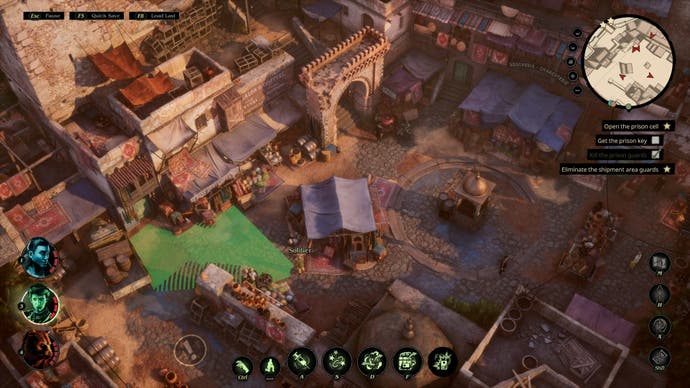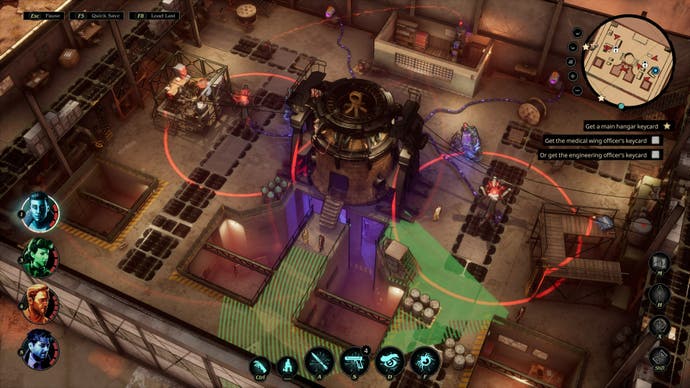Sumerian Six gets two things right immediately as far as I’m concerned. One, it lets you punch a bunch of Nazis in a pulpy 1930s setting, and two, it’s the kind of old-school, sight-cone-dodging stealth-tactics game I’m a sucker for. These things don’t come around too often, being a niche within a niche and all, and they feel especially rare now after the genre suffered a major blow last year when Desperados 3 and Shadow Tactics studio Mimimi Games announced it was shutting its doors. So you can probably imagine the little happy dance I did when Devolver Digital unveiled Sumerian Six and its paranormally imbued alternate-history WW2 action during Summer Game Fest season – even if that excitement was somewhat abated by the knowledge many of the team working on the game will likely no longer have jobs when it’s done.
Sumerian Six, though, gets off to a rip-roaring start as developer Artificer sets the scene with pulp-comic panache. Following The Great War, a military scientist named Alistair Sterling assembles a crack team of ‘scientist commandos’ known as the Enigma Squad to investigate Geistoff, a mysterious substance with seemingly limitless power. After their experiments go devastatingly wrong, the group is disbanded – but former member Hans Kammler betrays them, selling their research to a Third Reich eager to harness Geistoff’s power. We join the action in 1944, with WW2 well underway; Sterling’s daughter Isabella has gone radio silent while working undercover to infiltrate Kammler’s group, and her brother Sid is mounting a rescue mission to find out where she’s gone. Let’s go!
If you’re a long-time stealth-tactics fan, playing Sumerian Six should feel just like coming home. It adheres to the sight-cone dodging, cover seeking, squad juggling template established by the likes of Commandos back in the late 90s brilliantly, and it’s clearly, wisely, borrowing some of the refinements and ideas from Mimimi’s more modernised take on the genre, too.
It’s classic stealth-tactics through and through, then, settling straight into the genre’s familiar rhythms of patient environmental observation, careful planning, and timing-critical execution. And while Sumerian Six undoubtedly has a few issues – the demo’s unfortunately saddled with a cumbersome, frequently buggy mouse-driven UI that makes keyboard shortcuts a must – there’s plenty of early promise in its (still available) Steam Next Fest demo.
For starters, its gently comic book-styled environments are wonderfully realised (all snow-covered, Nazi-infested castles and picturesque mountainside villages), while its laidback wit, here mostly manifesting in the sibling rivalry between its leads, adds warmth and life to proceedings. It has fun elsewhere, too, incorporating a delightfully incongruous spy-funk soundtrack and a smattering of heist-movie-inspired mission briefings, both somehow fitting despite the 1930s setting.
Then there’s Sid and Isabella’s intriguing, sort-of-supernatural special abilities (hand-waved in-game with a vague ‘SCIENCE!’). Sid, for instance, can inhabit patrols to hitch a ride but has no direct control over them, while Isabella can swap places with an opponent within a set radius. Sumerian Six’s largely linear opening stages don’t, admittedly, leave much scope for tactical experimentation or interesting character synergies at this early stage, but things do pick up significantly from there.
Once out of Kammler’s castle, Sumerian Six’s action shifts to a sprawl of picturesque German countryside, all winding tracks and quaint cottages set against glorious mountain vistas – and it’s here Artificer starts to invite more free-form experimentation. The expansive environment, full of crisscrossing pathways and optional enemy encounters, is packed with possibilities, much more readily lending itself to interesting tactical decision-making.


Moreover, that’s only enhanced by the introduction of exiled chemist Rosa Reznick, whose distinctive chemical-based abilities are all rich with potential. She can melt Nazis on the spot so their bodies don’t need hiding, turn foes into walking bombs that can be triggered among groups of enemies, nudge opponents in specific directions with carefully tossed gas grenades, and even jab them with an IV drip to keep them quietly sedated for as long as she stays nearby. It’s a wonderfully flexible toolkit, and if Rosa’s ability design is indicative of Sumerian Six’s remaining characters, we’re in good hands.
Once the basic tutorial stuff is out the way, Sumerian Six really starts to find its groove. Intriguing synergies between characters begin to reveal themselves, alternate routes and optional objectives encourage greater tactical creativity, and there are moments it all coalesces into the kind of satisfyingly balletic flow of reconnaissance and execution you’d find in the best stealth-tactics games. By the time I was waving Sid and Rosa goodbye at the end of the demo after stealing a plane from an ultra-powerful Panzerwolf soldier who’d only go down after some… creative use of the environment, I was having a ball.
I still have concerns about Sumerian Six’s rubbish interface, mind, and I wish its early enemy encounters were a little more flexible to properly showcase the potential of its tools. But there’s enough promise in its scrappy little demo that I’m definitely eager for more. It might not have the polish and astute mechanical refinement of Mimimi’s best stealth-tactics games, but it does have heart and, I think, a fundamental understanding of what makes the genre sing. Plus, it looks like a bear joins your party to fight Nazis at some point, so I’m absolutely in.





